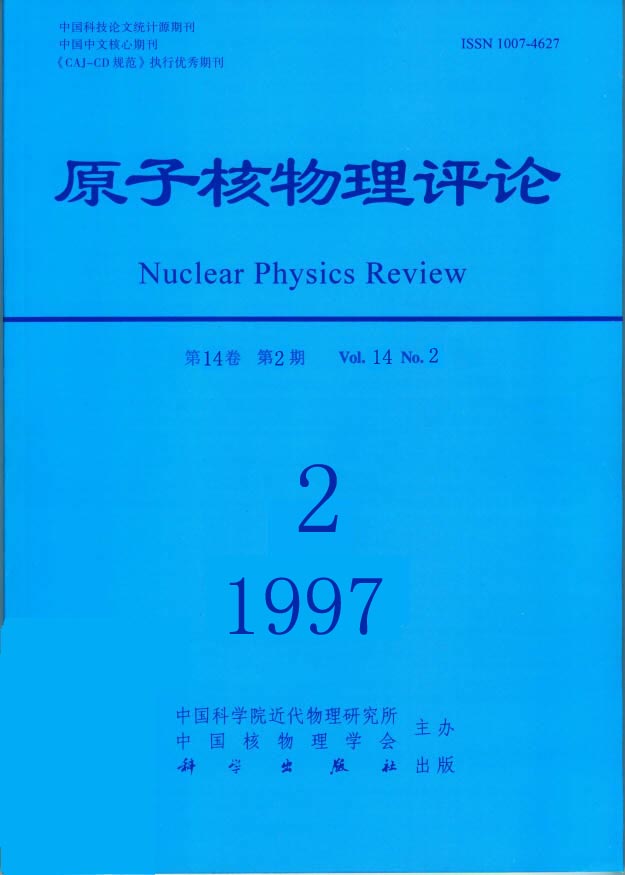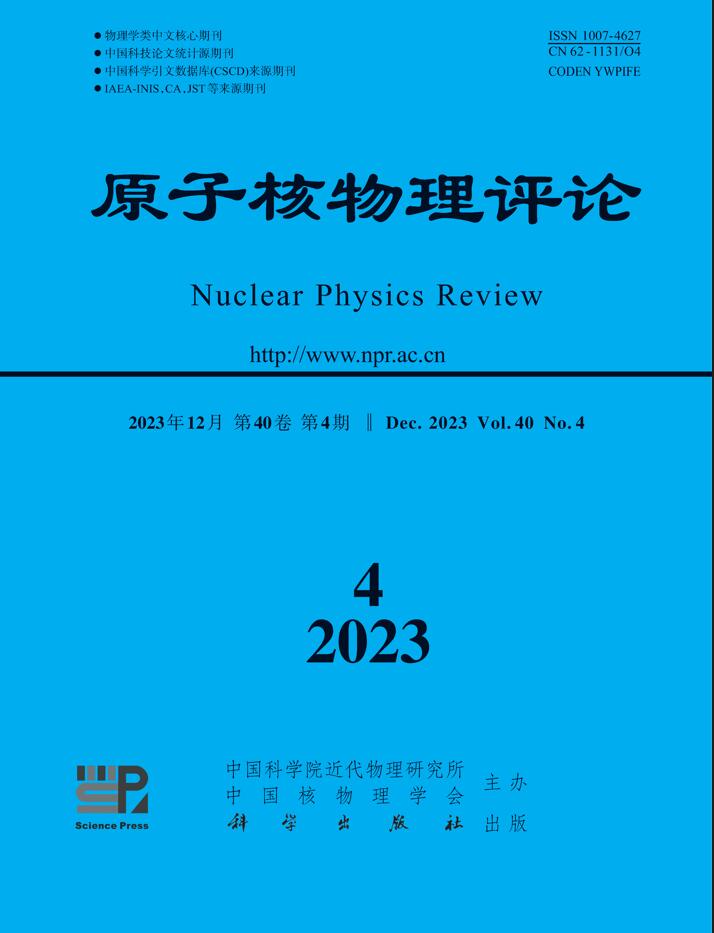1997 Vol. 14, No. 2

Display Method:
1997, 14(2): 69-74.
doi: 10.11804/NuclPhysRev.14.02.069
Abstract:
superdeformed bands in 20 nuclei of the A ~190 region are studied with formulas derived from the Cranking Bohr Mottelson Hamiltonian. From fitting the experimental E γ , the level spins are determined and mass parameter B 1 and rigidity parameter C 0 are obtained. The B 1 and C 0 values show clear odd even effects.
superdeformed bands in 20 nuclei of the A ~190 region are studied with formulas derived from the Cranking Bohr Mottelson Hamiltonian. From fitting the experimental E γ , the level spins are determined and mass parameter B 1 and rigidity parameter C 0 are obtained. The B 1 and C 0 values show clear odd even effects.
1997, 14(2): 75-78.
doi: 10.11804/NuclPhysRev.14.02.075
Abstract:
In this paper we present many observables of the nuclear reactions related to the temperature parameter,and several methods which devoted to the establishment of the nuclear temperature therometer.
In this paper we present many observables of the nuclear reactions related to the temperature parameter,and several methods which devoted to the establishment of the nuclear temperature therometer.
1997, 14(2): 79-87.
doi: 10.11804/NuclPhysRev.14.02.079
Abstract:
The article presents the new development at SFC, the HIRFL injector cyclotron. It concerns the new central region, the new buncher system, the new axial injection line, and the improvement of SFC vacuum system. The results and the expected results are given after these modifications are made. Especially it introduces the half frequency bunching method to increase the longitudinal matching efficiency between the injector and the main cyclotron, and the special treatment for the space...
The article presents the new development at SFC, the HIRFL injector cyclotron. It concerns the new central region, the new buncher system, the new axial injection line, and the improvement of SFC vacuum system. The results and the expected results are given after these modifications are made. Especially it introduces the half frequency bunching method to increase the longitudinal matching efficiency between the injector and the main cyclotron, and the special treatment for the space...
1997, 14(2): 88-91.
doi: 10.11804/NuclPhysRev.14.02.088
Abstract:
Stochastic cooling system in Cooling Storage Ring (CSR) at Lanzhou will help to cool beam phase space and increase the accumulation ratio and efficency. In this paper, a Fokker Planck eqution is described and used to simulate cooling process.According to the main parameters of CSR,cooling time of some typical ions has been calculated and the cooling forces of electron cooling and stochastic cooling are compared. Finally, A hardware designing plan is proposed.
Stochastic cooling system in Cooling Storage Ring (CSR) at Lanzhou will help to cool beam phase space and increase the accumulation ratio and efficency. In this paper, a Fokker Planck eqution is described and used to simulate cooling process.According to the main parameters of CSR,cooling time of some typical ions has been calculated and the cooling forces of electron cooling and stochastic cooling are compared. Finally, A hardware designing plan is proposed.
1997, 14(2): 92-98.
doi: 10.11804/NuclPhysRev.14.02.092
Abstract:
To deal with the SD bands, a single rotational model is proposed, i . e. freeze the degree of vibrational freedom, and regard the SD nuclei as a rigid rotor. Also, the Signature is considered to be a good quantum number . 10 SD bands were calculated, all of the assigned nuclear spins are equal to those determined by ab formula. 190 Hg and 152 Dy were also calculated, but the results of assigned nuclear spins are different to the ones of ab formula.
To deal with the SD bands, a single rotational model is proposed, i . e. freeze the degree of vibrational freedom, and regard the SD nuclei as a rigid rotor. Also, the Signature is considered to be a good quantum number . 10 SD bands were calculated, all of the assigned nuclear spins are equal to those determined by ab formula. 190 Hg and 152 Dy were also calculated, but the results of assigned nuclear spins are different to the ones of ab formula.
1997, 14(2): 99-101.
doi: 10.11804/NuclPhysRev.14.02.099
Abstract:
In high energy neutrino emulsion collisions, the normalized distribution of two particle relative pseudorapidity and the correlation between the mean maximum number density of shower particles and multiplicity are investigated.
In high energy neutrino emulsion collisions, the normalized distribution of two particle relative pseudorapidity and the correlation between the mean maximum number density of shower particles and multiplicity are investigated.
1997, 14(2): 102-105.
doi: 10.11804/NuclPhysRev.14.02.102
Abstract:
Newest progress in cancer therapy with heavy ion beam are briefly described in the paper, especially, the trends in United States, Japan, Germany and some European countries in recent years. Furthermore, some brief reviews for the trends are presented. According to the international trends and the potential of our country, our several considerations are proposed.
Newest progress in cancer therapy with heavy ion beam are briefly described in the paper, especially, the trends in United States, Japan, Germany and some European countries in recent years. Furthermore, some brief reviews for the trends are presented. According to the international trends and the potential of our country, our several considerations are proposed.
1997, 14(2): 106-110.
doi: 10.11804/NuclPhysRev.14.02.106
Abstract:
Present status in study of fast heavy ion beam induced plastic deformation in amorphous alloys is briefly reviewed. Further research trend and relevant problems are also discussed.
Present status in study of fast heavy ion beam induced plastic deformation in amorphous alloys is briefly reviewed. Further research trend and relevant problems are also discussed.
1997, 14(2): 111-113.
doi: 10.11804/NuclPhysRev.14.02.111
Abstract:
In this paper,the pin point effect and the magnetic self pinch of electrolysis are suggested to be the important factors to produce conditions that are far from equilibrium and are essential for cold nuclear fusion. Further studies of the structural and electronic properties of deuterium in bulk palladium, the behaviours of electrochemical double layer,and the localized emission sites on surface protrusions of the electrode should be extensively carried out for understanding the mechanism ...
In this paper,the pin point effect and the magnetic self pinch of electrolysis are suggested to be the important factors to produce conditions that are far from equilibrium and are essential for cold nuclear fusion. Further studies of the structural and electronic properties of deuterium in bulk palladium, the behaviours of electrochemical double layer,and the localized emission sites on surface protrusions of the electrode should be extensively carried out for understanding the mechanism ...
1997, 14(2): 114-117.
doi: 10.11804/NuclPhysRev.14.02.114
Abstract:
The following opinions were given in this paper. It is probably creditable that as X-ray with single energy was produced in discharge process with D2 gas
The following opinions were given in this paper. It is probably creditable that as X-ray with single energy was produced in discharge process with D2 gas
1997, 14(2): 118-120.
doi: 10.11804/NuclPhysRev.14.02.118
Abstract:
In this paper,by neutron radiation detection with the passive method, the study on detectability, neutron spectra, etc. for the plutonium combined systems including the stimulated nuclear warhead assembly are introduced. The sutdy on technique of measuring fission delayed neutrons from uranium materials and the method of distinguished nuclear from non nuclear materials with the active method are described. Further experiments on verifying technique are also discussed.
In this paper,by neutron radiation detection with the passive method, the study on detectability, neutron spectra, etc. for the plutonium combined systems including the stimulated nuclear warhead assembly are introduced. The sutdy on technique of measuring fission delayed neutrons from uranium materials and the method of distinguished nuclear from non nuclear materials with the active method are described. Further experiments on verifying technique are also discussed.
1997, 14(2): 121-124.
doi: 10.11804/NuclPhysRev.14.02.121
Abstract:
The concept for the clean nuclear power system driven by accelerator is presented. The status and progresses of several projects in the world are reviewed. The suggestions for the work to be done in China are proposed.
The concept for the clean nuclear power system driven by accelerator is presented. The status and progresses of several projects in the world are reviewed. The suggestions for the work to be done in China are proposed.
1997, 14(2): 125-129.
doi: 10.11804/NuclPhysRev.14.02.125
Abstract:
The background for developing object oriented software technique in high energy and nuclear physics has been introduced. The progress made at CERN and US has been outlined. The merit and future of various software techniques have been commented.
The background for developing object oriented software technique in high energy and nuclear physics has been introduced. The progress made at CERN and US has been outlined. The merit and future of various software techniques have been commented.







 甘公网安备 62010202000723号
甘公网安备 62010202000723号